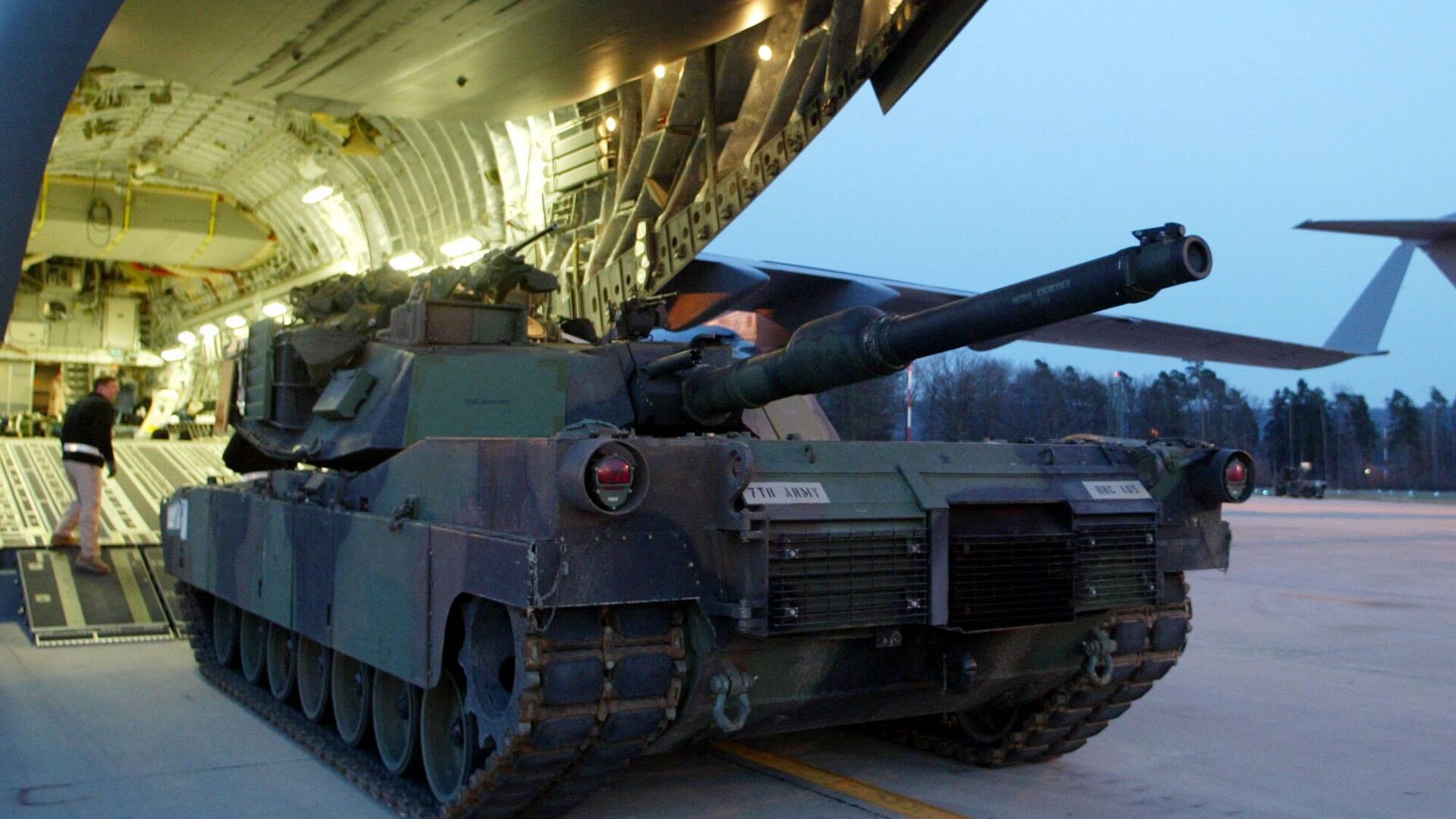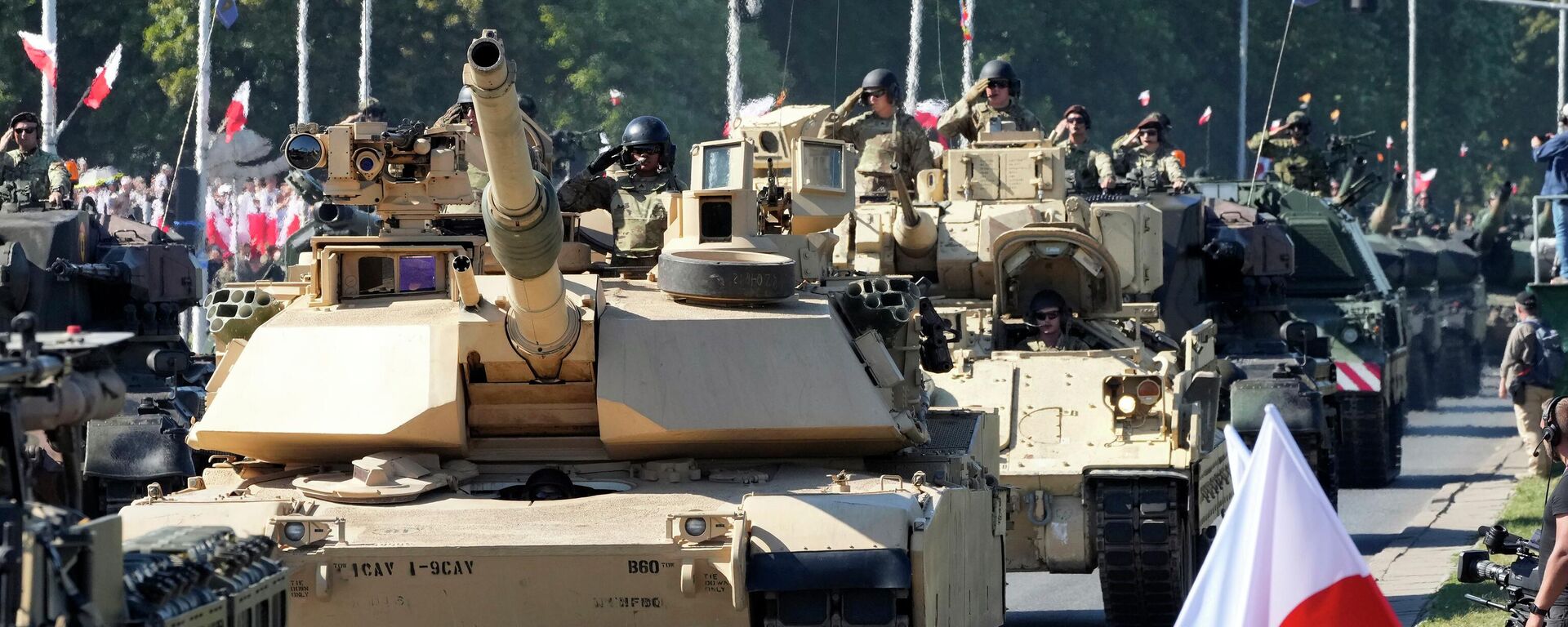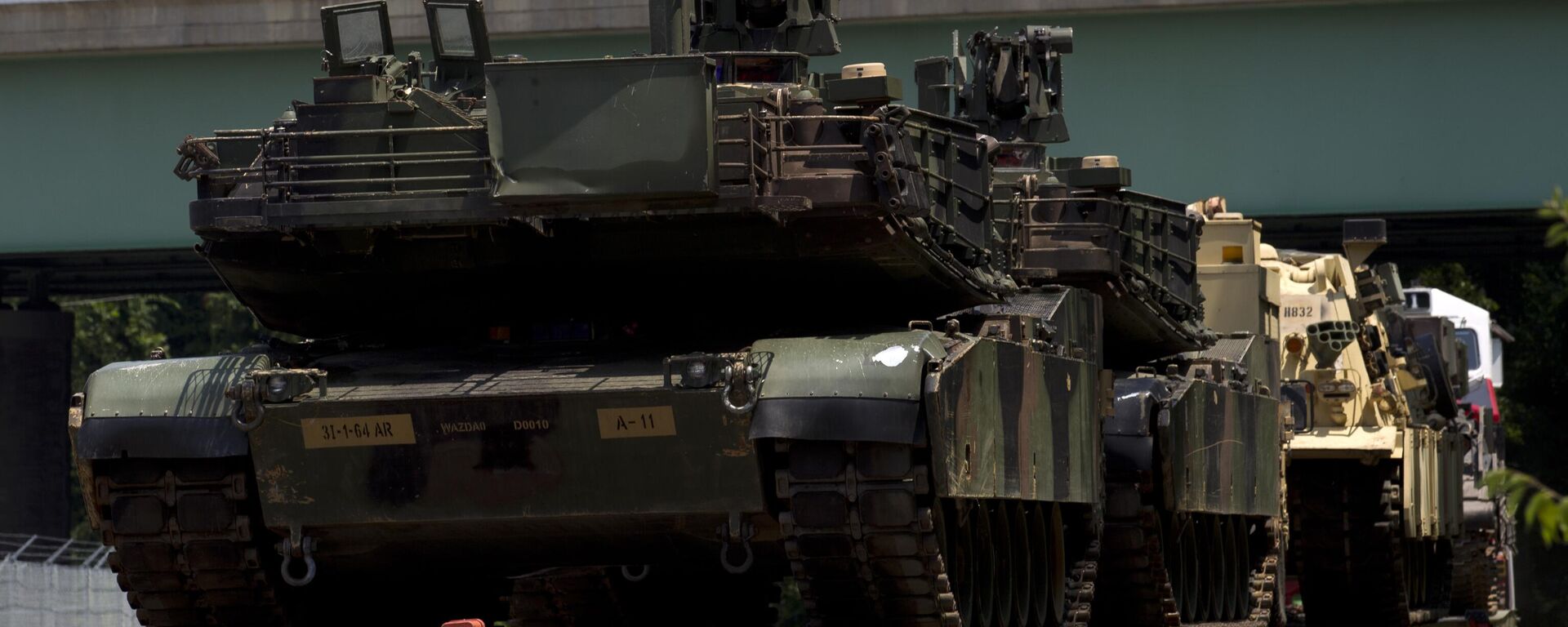How Will Russia Deal With American Abram Tanks in Ukraine?
17:39 26.09.2023 (Updated: 17:40 26.09.2023)

© AP Photo / JAN PITMAN
Subscribe
On Moday, Ukrainian officials announced that the first batch of the 31 promised M1 Abrams main battle tanks had arrived in the country. What tools does Russia possess to handle the American-made armor? Sputnik did some digging to find out.
Ukraine has received some of its long-promised Abrams tanks, with the rest scheduled to be delivered later this fall. The long wait began in January, when President Biden announced that a battalions’ worth of America’s best tanks would be sent to “improve” Ukraine’s “ability to maneuver in open terrain.”
The Abrams are the last of three NATO heavy tank platforms to be delivered to Ukraine to date, with Washington using promises about their deployment to get the alliance’s European members, particularly Germany, to approve the sending of their Leopard series MBTs [hundreds of Leopard 1 and Leopard 2 tanks have been sent to Kiev since then]. The UK also joined in, sending 14 of its fearsome Challenger 2s–boasting the status of one of the only major MBTs in NATO armies’ service never to have been destroyed by the enemy in battle.
Russian forces taking on Ukraine’s NATO-equipped Army during the summer counteroffensive soon changed all that, with dozens of Leopard 1 and Leopard 2s knocked out, and at least two of Britain’s ‘unbeatable’ tanks taken out in fierce fighting in Zaporozhye after finally appearing on the battlefield earlier this month.
The Pentagon outlined its expectations for its Abrams tanks in Ukraine, saying in a statement Monday that "by having these tanks in their arsenal, the Ukrainian Army can more effectively discourage aggressive actions."
That’s a far cry from NATO leaders’ lofty expectations just a few months ago, as Ukraine was only starting its counteroffensive. In June, NATO Chief Jens Stoltenberg assured US President Joe Biden that Western weapons were “making a difference on the battlefield as we speak,” and that Ukrainian forces were “gaining ground.” “It’s still early days, but what we do know is that the more land that Ukrainians are able to liberate, the stronger hand they will have at the negotiating table,” he added.
Three-and-a-half months on, the counteroffensive appears to have ground to a halt, with Ukraine’s military taking horrendous losses, and burning through tens of billions of dollars in NATO arms and ammunition with very little to show for it in terms of territorial gains.
What Tools Does Russia Have at Its Disposal to Target Abrams?
Ukraine’s counteroffensive has given Russian forces plenty of experience to learn what works and what doesn’t when it comes to targeting NATO heavy tanks like the Abrams.
First, as far as strategy goes, the counteroffensive has shown that simply luring tanks into heavily mined territory can often be sufficient, with many Ukrainian armored thrusts foiled after running into minefields and dragon’s teeth defenses, and Kiev even reportedly pulling tanks like the Leopard 2 from the front and resorting to using infantry to advance on foot to avoid losing the armor.
Second, there’s the factor of Russia’s qualitative and quantitative superiority in artillery and airpower, with the latter enabling Russian forces to use Kamov Ka-52 and Mil Mi-28 attack helicopters to hunt for Ukrainian tanks with laser-guided missiles, and doing so at standoff ranges, often making it impossible for Ukraine’s air defenses to respond.
The third factor is Russia’s own armor, with upgraded T-72B, T-72B3M, T-80 and T-90M series tanks proving more than a match for Ukraine’s comparable Soviet-era armor and NATO MBTs, and Russia enjoying superiority in numbers, GPS jamming capabilities which frustrate enemy precision-guided munitions and combat drones, and superior range characteristics of its main guns on some models.
Fourth, there are the anti-armor capabilities of Russian infantry armed with man-portable anti-tank missile systems like the Kornet, designed specifically to target the latest generation of NATO’s main battle tanks, including the Abrams. Long before Ukraine’s counteroffensive began, Sputnik warned about the Kornets’ deadly effectiveness against Turkish Army Leopard 2A4s in Syria, US Army Abrams and Bradley infantry fighting vehicles in Iraq, and Israeli Merkava tanks in Lebanon. Western MBTs already deployed in Ukraine have now suffered a similar fate at the hands of Russian man-portable anti-tank systems, and Abrams will too, if they’re deployed close enough.
What are the Abrams' Weak Spots?
The Abrams tanks Ukraine is getting aren’t up to the same standard as those used by the US military. While its tanks are receiving the same controversial depleted uranium munitions which the US and NATO have already successfully used to poison wide swathes of the former Yugoslavia and Iraq, they are not equipped with the same layer of ultra-thick DU armor plates for enhanced protection of the tank and its crew that US Army Abrams have.
Ukraine’s Abrams are made from refurbished hulls and turrets from California’s Sierra’s Army Depot, with their DU armor plating removed for secrecy reasons. With the tanks proving vulnerable to enemy anti-tank systems even with the DU armor installed, Russian forces should have no problems using any or all of the above-mentioned weapons systems to target them.
The infographic below highlights some of the weak spots of the Abrams outlined by Russian military experts.
The Abrams’ side skirts, as well as the sides and rear of the turret and engine compartment/engine air intake to the tank’s rear are vulnerable to man-portable anti-tank systems, including the aforementioned Kornet, plus similar systems like the Konkurs, the Shturm-S and the Khrizantema, which feature tandem-charge rounds.
Finally, the Abrams turrets’ front armor, and turret top are vulnerable to Ka-52 and Mil Mi-28 helicopters equipped with Shturm, Ataka and Vikhr anti-tank missiles.
"On most Western models of armored vehicles and equipment, the sides and rear areas tend to be vulnerable," Sergey Suvorov, a retired Russian Army colonel and candidate of military sciences specializing in armor, told Sputnik. "There were cases in Iraq in which Abrams were knocked by fire from 25 mm Bradley autocannons and the BMP 2’s 30 mm autocannons. There was even a case of an Abrams in Iraq knocked out using a DShK heavy machine gun," the observer explained.
These losses were not typically treated as such, but chocked up to losses from ‘secondary causes’. Nevertheless, the tanks were destroyed, with a bullet in the case of the DShK attack ending up hitting an auxiliary power unit located at the rear of the turret, with burning oil flowing into the main power plant, the engine catching fire and the tank burning up, Suvorov recalled.
The Abrams’ front armor gives the tank good protection, according to Suvorov, although the large angle of the hull’s inclination means that if a projectile ricochets off of it into the space between the turret and the hull, the tower may be penetrated. The same goes for the turret’s top, and the engine and transmission compartments, whose armor the observer said tend to be weaker than that of comparable Russian tanks.
“If we compare the Abrams to the latest Leopards, the gun on the Abrams is a German Rheinmetall gun, produced under license in the USA, but one of its earliest variants, that is, the same as that on Leopard 2 A4s, with a 44-caliber barrel length. The latest Leopards have a 55-caliber gun with a strong charging chamber, which allows for the use of new ammunition creating greater gas pressure in the charging channel and, accordingly, have a greater initial velocity, meaning better armor penetration,” Suvorov said.
This new generation of shells cannot be used on the Abrams, according to the expert, since the force generated by the round would simply wreck the main cannon.
“On top of that, the Abrams’ gun has a short barrel. Furthermore, the gas turbine engine really doesn’t seem to like dust. The air purification system has not been improved. Operational experience in desert environments, particularly in Iraq, has shown that air purifiers and filters would last as little as 15 minutes in conditions of war in a dust storm. It was necessary to remove these filters or replace or clean them, because the filter system there is like that of a car…If this is not done, the tank will stop working altogether,” Suvorov said.
Along with the above mentioned weapons systems, Suvorov believes that “any” modern anti-tank weapon in service with the Russian military, starting with RPG-7 hand-held anti-tank grenade launchers, will pose a threat to Ukraine’s Abrams tanks, judging by their performance in US wars in the past. The same goes for any Russian tank guns equipped with armor-piercing shells, and any modern anti-tank missiles, with cases recorded in Iraq of even the 100-mm gun of the ancient T-55 mm tanks defeating an Abrams. “It’s also highly likely that drones will be able to defeat these tanks,” he added.
Finally, there are the conditions under which the tanks will be operating in in Ukraine to consider, according to the observer. “The tank is quite heavy, weighing about 70 tons. Now the rains and mud will begin, they will get stuck and stand there, serving as targets” for Russian forces, Suvorov summed up.



